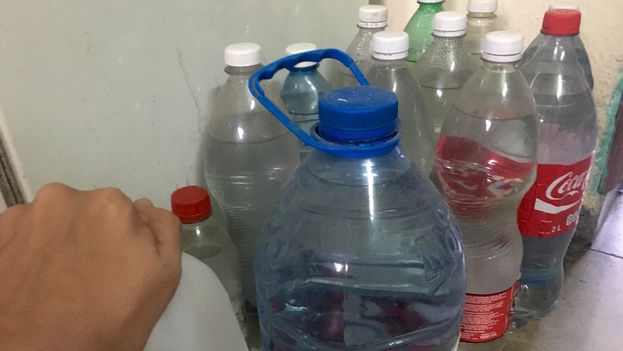
![]() 14ymedio, Havana, 29 May 2017 — Four days after the rupture of Havana’s main water conduit, authorities are trying to alleviate the shortage by servicing some parts of the city with tanker trucks. As of this Sunday, according to a director for Water Resources, they had made 1,315 trips with 117 water trucks that are now “guaranteeing” the supply. The greatest effects are felt in the municipalities of Plaza de la Revolucion, Cerro, 10 de Octubre, Habana Vieja, Centro Habana and in some areas near Boyeros.
14ymedio, Havana, 29 May 2017 — Four days after the rupture of Havana’s main water conduit, authorities are trying to alleviate the shortage by servicing some parts of the city with tanker trucks. As of this Sunday, according to a director for Water Resources, they had made 1,315 trips with 117 water trucks that are now “guaranteeing” the supply. The greatest effects are felt in the municipalities of Plaza de la Revolucion, Cerro, 10 de Octubre, Habana Vieja, Centro Habana and in some areas near Boyeros.
The rupture has caused the loss of 3,000 liters of water per second from the network, as officials from the area confirmed on the news Sunday. Although they are confident that the situation can be partially overcome with “new distribution plans,” the failure is very complicated because it affects almost a kilometer of the southern catchment area’s conduit. It is not expected that the problem will be resolved before next Thursday.
Brigades under the direction of Havana’s provincial Water Resources have worked “continuously,” they assert, in order to remedy the malfunction, but it is necessary to replace a total of 400 meters that are obstructed, which complicates even more the work that they are carrying out.
One of the area’s managers asserted that they are trying to restore the prior conduit and that they have already put in place “a kilometer of 900-millimeter pipe and four welding machines that are soldering “full time.”
Engineer Javier Toledo, Provincial Delegate for Water Resources, said that they can say that “on Thursday morning” it is “very possible” that the first supply lines may be opened. Thus they will be able “to slowly begin to re-establish service.”
With the first two lines’ entry into service, a greater water level may be counted on to reach the People’s Council areas which continue to experience supply problems, as the expert explained.
Toldeo thought that, as far as distribution, “the most difficult moment” has been overcome and “the cycles, services and delivery of services to the people” are now balancing out. Also, he asserted that “every day” they are determining “place by place” the best way of distributing water in order to guarantee that it arrives “equitably” and that there is no area that does not receive it “by networks” or tanker trucks.
Water Resources daily decides and projects the capital’s water supply service’s cycles. The strategy is designed after evaluating “current conditions” and based on calls from users.
The capital’s most important hotels are located in several of the affected municipalities, like Habana Vieja and Plaza de la Revolucion, in the midst of a busy tourist season. These establishments, along with schools and hospitals, are being prioritized for supply by tanker trucks.
Cuba is experiencing its most intense drought of the last century, a situation that has been aggravated by the few rains that the wet season has so far contributed. On the other hand, due to the failures and leaks, the country is losing more than half the water it pumps.
Translated by Mary Lou Keel
